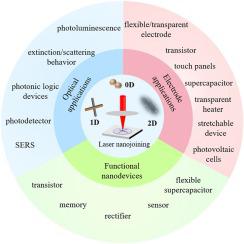当前位置:
X-MOL 学术
›
Nano Today
›
论文详情
Our official English website, www.x-mol.net, welcomes your
feedback! (Note: you will need to create a separate account there.)
Laser-induced Joining of Nanoscale Materials: Processing, Properties, and Applications
Nano Today ( IF 13.2 ) Pub Date : 2020-12-01 , DOI: 10.1016/j.nantod.2020.100959 Ming Xiao , Shuo Zheng , Daozhi Shen , Walter W. Duley , Y. Norman Zhou
Nano Today ( IF 13.2 ) Pub Date : 2020-12-01 , DOI: 10.1016/j.nantod.2020.100959 Ming Xiao , Shuo Zheng , Daozhi Shen , Walter W. Duley , Y. Norman Zhou

|
Abstract The rapid development of flexible and wearable nanodevices for a variety of commercial applications has identified a pressing need for targeted research on nanomaterials for use as building blocks in the fabrication of functional devices via bottom-up assembly. In the search for new fabrication technology, nanojoining or nanowelding has been selected as a promising method in this bottom-up approach. While there are a number of methods that can be used for nanojoining, laser processing is of interest because laser nanojoining combines high-precision property with a flexible manufacturing platform. In this review we discuss how this technology can be implemented in practical applications and outline the advantages and limitations of laser-induced nanojoining. We emphasize how laser nanojoining introduces reliability and reproducibility to the joining process, and show that this is due to precise control over heat-input in nanoscale dimensions. We also review the ways in which laser nanojoining can be integrated with other commercial fabrication operations in practical applications. To illustrate the flexibility of laser nanojoining, we give a detailed summary of joining involving a wide variety of multidimensional heterogeneous nanomaterials in the form of zero-dimension, one-dimension and two-dimension as well as the hybrid combination of these building blocks. We also discuss how laser processing can be used to generate hybrid materials with new functionalities as electrodes for various devices, optical systems and in functional circuits. The mechanisms and strategies in laser-induced joining of nanomaterials are systematically discussed in this paper along with a review of the properties and applications of the joined nanostructures. We also review some challenges in the implementation of this technology and discuss some possible directions for future research into laser-induced nanojoining.
中文翻译:

纳米材料的激光诱导连接:加工、性能和应用
摘要 用于各种商业应用的柔性和可穿戴纳米设备的快速发展已经确定了对纳米材料的针对性研究的迫切需要,该纳米材料用作通过自下而上组装制造功能设备的构建块。在寻找新的制造技术的过程中,纳米连接或纳米焊接已被选为这种自下而上的方法中的一种有前途的方法。虽然有多种方法可用于纳米连接,但激光加工是令人感兴趣的,因为激光纳米连接将高精度特性与灵活的制造平台相结合。在这篇综述中,我们讨论了如何在实际应用中实施这项技术,并概述激光诱导纳米连接的优点和局限性。我们强调激光纳米连接如何为连接过程引入可靠性和可重复性,并表明这是由于对纳米级热输入的精确控制。我们还回顾了激光纳米连接在实际应用中与其他商业制造操作相结合的方式。为了说明激光纳米连接的灵活性,我们详细总结了涉及各种多维异质纳米材料的零维、一维和二维形式的连接以及这些构建块的混合组合。我们还讨论了如何使用激光加工来生成具有新功能的混合材料,作为各种设备、光学系统和功能电路的电极。本文系统地讨论了激光诱导纳米材料连接的机制和策略,并回顾了连接纳米结构的性能和应用。我们还回顾了该技术实施中的一些挑战,并讨论了未来激光诱导纳米连接研究的一些可能方向。
更新日期:2020-12-01
中文翻译:

纳米材料的激光诱导连接:加工、性能和应用
摘要 用于各种商业应用的柔性和可穿戴纳米设备的快速发展已经确定了对纳米材料的针对性研究的迫切需要,该纳米材料用作通过自下而上组装制造功能设备的构建块。在寻找新的制造技术的过程中,纳米连接或纳米焊接已被选为这种自下而上的方法中的一种有前途的方法。虽然有多种方法可用于纳米连接,但激光加工是令人感兴趣的,因为激光纳米连接将高精度特性与灵活的制造平台相结合。在这篇综述中,我们讨论了如何在实际应用中实施这项技术,并概述激光诱导纳米连接的优点和局限性。我们强调激光纳米连接如何为连接过程引入可靠性和可重复性,并表明这是由于对纳米级热输入的精确控制。我们还回顾了激光纳米连接在实际应用中与其他商业制造操作相结合的方式。为了说明激光纳米连接的灵活性,我们详细总结了涉及各种多维异质纳米材料的零维、一维和二维形式的连接以及这些构建块的混合组合。我们还讨论了如何使用激光加工来生成具有新功能的混合材料,作为各种设备、光学系统和功能电路的电极。本文系统地讨论了激光诱导纳米材料连接的机制和策略,并回顾了连接纳米结构的性能和应用。我们还回顾了该技术实施中的一些挑战,并讨论了未来激光诱导纳米连接研究的一些可能方向。











































 京公网安备 11010802027423号
京公网安备 11010802027423号